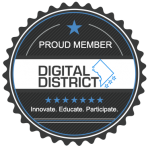
On Wednesday, November 12, Digital District denizens met at The Loft for a timely panel on elections and advocacy in the digital age. On the panel were of the Republican National Committee, of Phone2Action and of AARP.
During the event, we learned that there has been what Parman describes as a “sea change” in recent years. More campaigns and organizations are turning to social media and digital advocacy to inform the public and drive votes, and the proven effectiveness of these tools is leading to increased focus in terms of campaign finances and tailored content.
There are several key reasons social campaigns are effective when it comes to elections and advocacy:
1. Social has an accelerating effect when it comes to receiving and sharing information. A candidate can get a lot of data from digital advocacy initiatives, and information gleaned from social interactions with [potential] voters and constituents helps candidates tailor their campaigns quickly and strategically.
“You’re going to make mistakes along the way & you want to find out how to fix them before it costs too much.”
— Digital District ()
Data collection gets rid of middle-of-the-road messaging. Knowing how to talk to your audience is key to digital advocacy
— Bronwyn Flores ()
2. Digital advocacy cuts down on the information delay of elections past. Now, voters are able to learn about a candidate and their platforms, and compare them with other candidates, much more nimbly.
3. Social allows campaigners to engage with people where they are. In the “olden days” of elections and advocacy, campaigners had to be strategic about where they should position themselves to reach the largest number of constituents. Today, social provides a digital town square, so to speak, facilitating much easier, faster exchange of information.
4. Information tends to be much more engaging and carry more weight when it comes from a friend, rather than directly from a candidate or organization. Social and digital advocacy campaigns facilitate the amplification of information, allowing the candidate or campaign’s supporters to share with their networks, add commentary, and engage on their behalf.
However, lest anyone thinks we are moving into an all-digital campaign and advocacy future, our panelists warn that there are shortcomings:
1. You can’t put all your advocacy eggs in the digital basket, so to speak. Campaigners need to strategically employ other, often more traditional tactics–like print and broadcast media and activity on the ground–to have the greatest impact.
“Data scientists control what’s in your algorithm.” – says you also learn organically from your community — Digital District ()
. “If you’re only on the ground, it doesn’t work. If you’re only online, it doesn’t work.” — Digital District ()
2. You need to not only think about how your voter audience differs demographically and in the issues that matter to them, but in the way they use technology. Digital messaging is still not one-size-fits all and outreach methods using technology varies widely among populations. For example, Spanish-language speakers tend to be heavy mobile users and may respond better to messaging with an overall more positive, festive sentiment.
. says biculturalism is just as important as bilingualism. Not everything is a direct translation
— Digital District ()
3. Campaigners need to keep their primary goal in mind. While social interaction is great, voters still ultimately need to be converted to act.
The easiest way to know if something is working is if people take an action
— Meghan Raffa ()
In the end, our panelists and audience agree that technology and the new possibilities within the digital world are changing the game, and we are all excited to see what’s to come.
“Just like has disrupted everything else, it’s going to disrupt politics.” Amen, sista
— Bronwyn Flores ()
Catch up with the conversation on Twitter using hashtag . To see data visualized for the hashtag, checkout our tracker on Keyhole.
Thank you to our sponsors:
The Loft at 600 F is a brand new, vibrant, exciting & inviting event space in the Penn Quarter / Chinatown neighborhood of Washington DC directly across the street from the Verizon Center. Perched on the third and fourth floors of a downtown historic building, the light-filled, modern spaces can be set in various layouts ranging from a comfy lounge to a formal conference table or from an engaging lecture to an inviting happy hour. Chic furnishings and exposed brick are accented with modern technology in the perfect downtown location making The Loft at 600 F the best new place to meet in DC.
SignBlox is a breakthrough list-building and social action center that builds unique-to-person social media cards for your supporters.


Trackbacks/Pingbacks